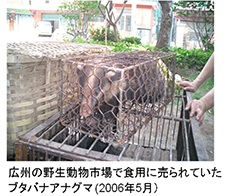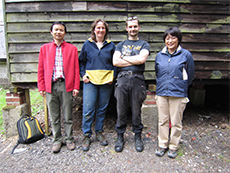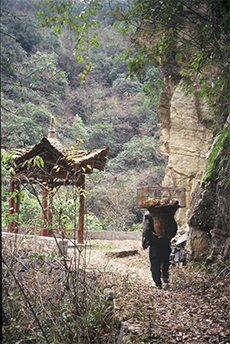

中国南部に同所的に生息するアナグマ3属 (ユーラシアアナグマMeles, ブタバナアナグマArctonyx, イタチアナグマ Melogale) 、キエリテン、ハクビシンの比較社会生態と保全
中国の高山と深い渓谷は、氷河時代にはレヒュージとして機能し、2800種以上の木本類、パンダやユキヒョウなどの希少哺乳類を擁する多様性の高い温帯林を生み出しました。特に中高標高域の森林の保水機能は、過酷な旱魃や洪水、土壌浸食を防ぎ、さらに下流域の灌水による集約農業を可能にし、世界でもっとも森林への依存が高い文明地域と言われてきました。しかし近年、中国南部をとりまく問題点は山積しています。行き過ぎた森林伐採により、例えば四川省の森林被覆率は1970年代には9%にまで減少し、森林棲の野生鳥獣のハビタットは消失し、地域・国家規模の絶滅が見られます。さらに特記すべき内容として、哺乳類では国立自然保護区 (National Nature Reserve、以下NNR) にすら人間活動による食肉目個体群の衰退、すなわち経済的資源としての野生動物の利用を目的とした密猟が生じています。この背景として、既存の野生動物に対する価値観(漢方薬、中大型食肉目の食肉利用)と、西洋化・資本主義の大量生産大量消費型の価値観が混在し、野生動物保護について理解や、その生息地としての管理方針が一貫性を欠いていることがあげられます。
中国にはアナグマ類が複数種生息するが、中でもブタバナアナグマ(Arctonyx collaris) は、IUCNの絶滅危惧種に指定され緊急な保護が必要とされます。しかし、アジア東部の文化的独自性を考えると、欧米で発達したConservation Biology(保全生物学)だけでなく、アジアにおいてWildlife Conservationを達成するための科学的根拠と動物と人間との関わりに関する具体的な情報を蓄積することが必要であると考えられます。特に食肉目動物を食料として利用するという伝統はアジア以外の地域にはみられない特徴です。したがって現在の中国、特に野生動物の生息地域の社会経済的状況や、地域住民の野生動物に対する意識や利用状況、流通に関する情報が不可欠です。この研究では、生態調査と並行して人間による野生動物の利用状況の実態把握(漢方薬や食品としての利用状況やこれらの流通をめぐる問題点)について調査し、国立自然保護区において実行可能な保全策と地域住民との合意形成内容について考察を行っています。
The conservation of carnivore community diversity in South China
In East Asia, wild carnivore species face threats of international significance prompting the need for urgent conservation measures. Without rigorous scientific research, however, we simply do not have enough understanding of the diverse issues surrounding conservation policy and sustainable exploitation to address these issues. The major threats to carnivore conservation in this region appear to hinge on the marked decline in populations of native species, compounded by the increased risk of transmission of zoonotic disease, caused by human activities and/or interactions with wildlife. Using carnivores in traditional medicine, for food and in the fur trade causes the severe perturbation or even local extirpation of carnivore populations. These threats are often compounded by human activities that create habitat fragmentation and degradation, or through the mis-management of captive or farmed animals. Not least, such problems make carnivore conservation a more challenging and complex issue for wildlife biologists.
In accordance with the Convention on Biological Diversity (1993), which China has adopted, the following objectives will have bearing on our research, namely:
1) To conserve biodiversity (inc. genetic diversity and habitats)
2) To address the economic value of biodiversity conservation
3) To ensure an equitable share / participation in the value of wildlife for native people
The overarching goal of this project is to investigate and achieve measures necessary for the protection of significant native habitats in southern China. Particular emphasis will be given to the conservation, welfare and sustainable exploitation of three badger species (Meles, Arctonyx and Melogale). We will focus on the interactions between native people and badgers, evaluating the most critical steps for protecting habitat by means of community habitat management. Despite South China having being identified as one of the World’s ‘biological hotspots’ and renowned as an area rich in Mustelid species diversity, four of the five native badger species are listed as threatened according to China’s own Species Red List (Meles leucurus: Critically Endangered (CR); M. meles: NT; Arctonyx: Vulnerable; Melogale moscata: NT; M. personata: Not Applicable (NA)). In the IUCN RDB (2006), Arctonyx, despite being widespread, was confirmed as Near Threatened (NT) and therefore this species will be periodically reassessed for the Red List in light of ongoing threats and uncertainty about levels of regional exploitation of this species. A major factor contributing to badger conservation is the rapid socio-economic changes that have progressed rapidly in China, impacting on both land use and the lifestyles native people. Consequently significant issues face badgers regionally:
1) The exploitation of badgers by people, for reflecting general societal attitude towards carnivores,
2) Lack of large-scale research assessing population structure and species life histories, including an
awareness of habitat requirement relevant to effective conservation measures.
To this end the Project will focus on:
1. Badger exploitation in wildlife trade and farming
2. General attitude to carnivores
3. Ecological evaluation of carnivore diversity affected by farms and wildlife marketing
Importantly, we will also evaluate the potential for synergistic habitat protection measures for three badger species through the management of National Nature Reserves (NNR). Badgers play a substantial role in ecosystem dynamics and forest regeneration in three NNR zones. This project will produce recommendations to the Chinese Government's Forestry Department to reconcile local traditions of native carnivores (badgers) exploitation with the sustainable conservation of biodiversity in East-Asia.
Publications
Zhou, Y., Zhang, L., Kaneko, Y., Newman, C., Zhang, S. 2008. Frugivory and seed dispersal by a small carnivore, Melogale moschata, in a fragmented subtropical forest of central China. Forest Ecology and Management 255: 1595-1603.
Zhang, L., Zhou Y., Newman, C., Kaneko,Y., Macdonald, D.W., Pingping, J., Ding, P. 2009. Niche overlap and sett-site resource partitioning for two sympatric species of badger. Ecology, Ethology and Evolution 21: 89-100.
Zhang, L., Zhou Y., Newman, C., Kaneko, Y., Pingping, J., Ding, P. 2010. Ranging and activity patterns of the group-living ferret badger Melogale moschata in central China. Journal of Mammalogy 91:101-108.
Masuda, R., Lin, L., Pei, K.J., Chen, Y., Chang, S., Kaneko, Y., Yamazaki, K., Anezaki, T., Yachimori, Y., and Oshida, T. 2010. Origins and Founder Effects on the Japanese Masked Palm Civet Paguma larvata (Viverridae, Carnivora), Revealed from a Comparison with Molecular Phylogeography in Taiwan. Zoological Science 27: 499-505.
Zhou, Y., Newman, C., Buesching, C.D., Zalewski, A., Kaneko, Y., Macdonald, D.W. & Xie, Z.Q. 2010. Biogeographical patterns in the diet of genus Martes across the Holarctic region: factors affecting trophic diversity. Journal of Biogeography. doi:10.1111/j.1365-2699.2010.02396.x
Zhou, Y.B., Newman, C., Buesching, C.D., Zalewski, A., Kaneko, Y. & Macdonald, D.W, Xie, Z. 2011. Diet of an opportunistically frugivorous carnivore, Martes flavigula, in subtropical forest. Journal of Mammalogy 92(3): 611-619.
Inoue, T., Kaneko, Y., Yamazaki, K., Anezaki, T., Yachimori, S., Ochiai, K., Lin, L., Pei, K.J. Chen, Y., Chang, S., Masuda, R. 2012. Genetic population structures of the masked palm civet Paguma larvata (Viverridae, Carnivora) in Japan and Taiwan, revealed from analysis of newly developed compound microsatellites. Conservation Genetics 13:1095-1107.
Newman, C., Zhou, Y., Buesching, C.D., Kaneko, Y. and Macdonald, D.W. 2011. Contrasting sociality in two widespread, generalist, mustelid genera, Meles and Martes. Mammal Study 36: 169-188. Mammal Study Award 2011


 中国科学院植物学研究所にて
中国科学院植物学研究所にて オックスフォード大動物学部Wildlife Conservation Research Unitにて。Dr Buesching(中央左), Dr Newman(中央右)
オックスフォード大動物学部Wildlife Conservation Research Unitにて。Dr Buesching(中央左), Dr Newman(中央右)
 ブタバナアナグマに発信機を付けるために捕獲罠を運ぶところ。
ブタバナアナグマに発信機を付けるために捕獲罠を運ぶところ。
